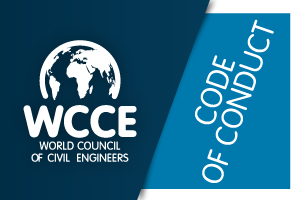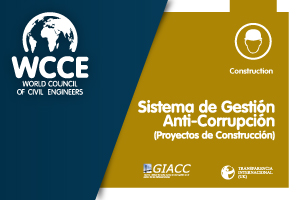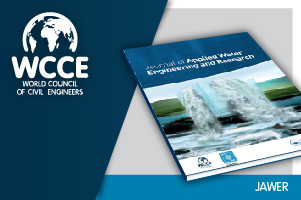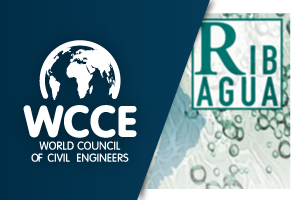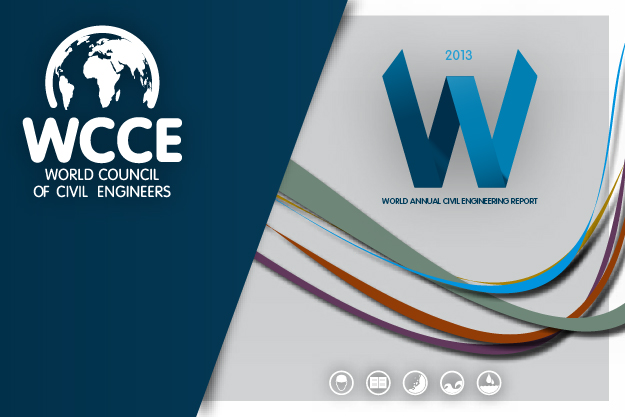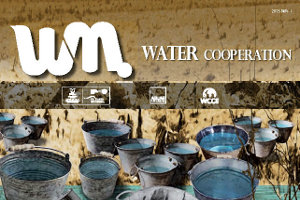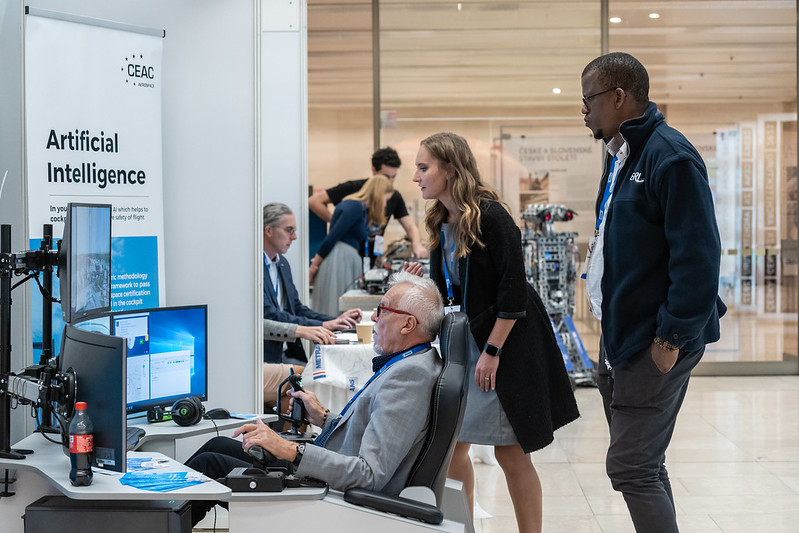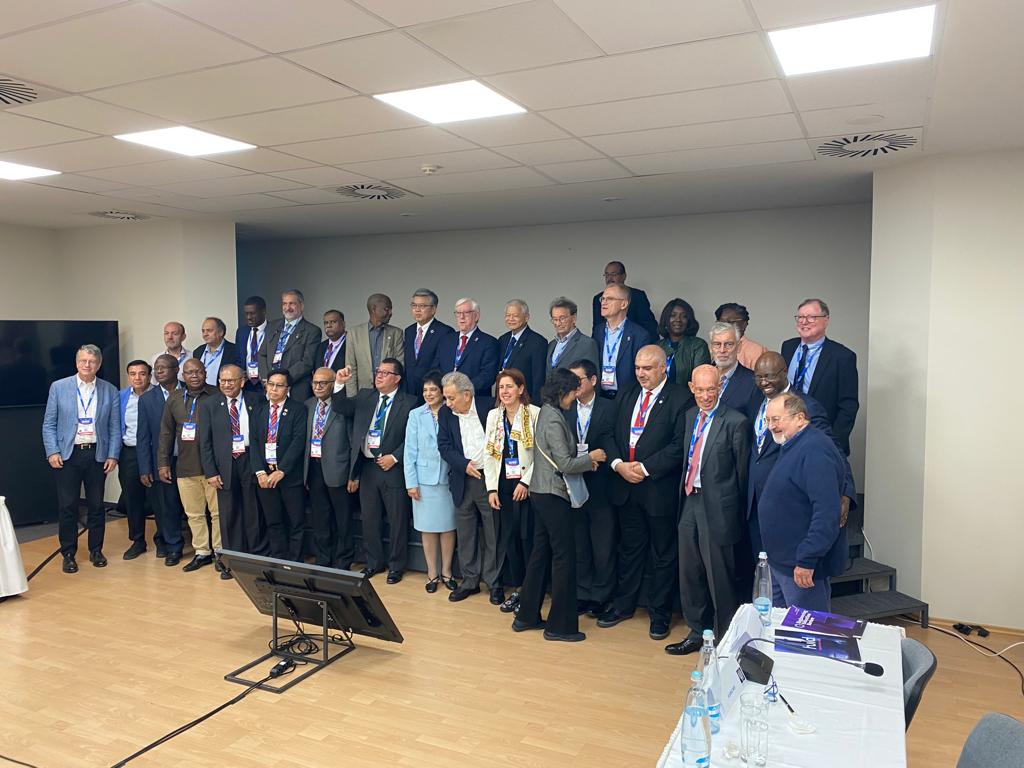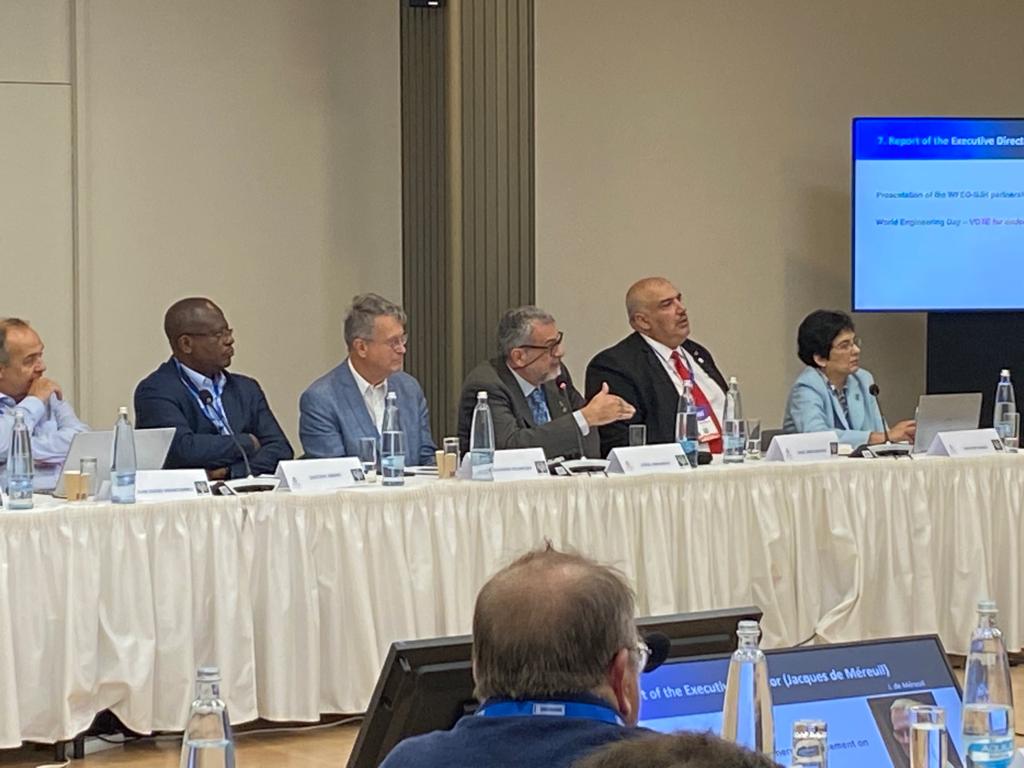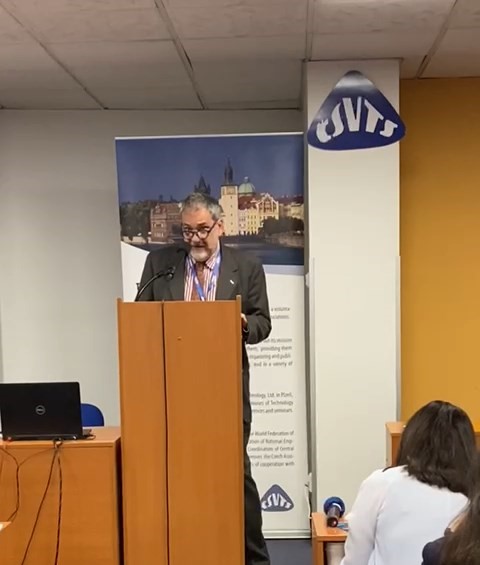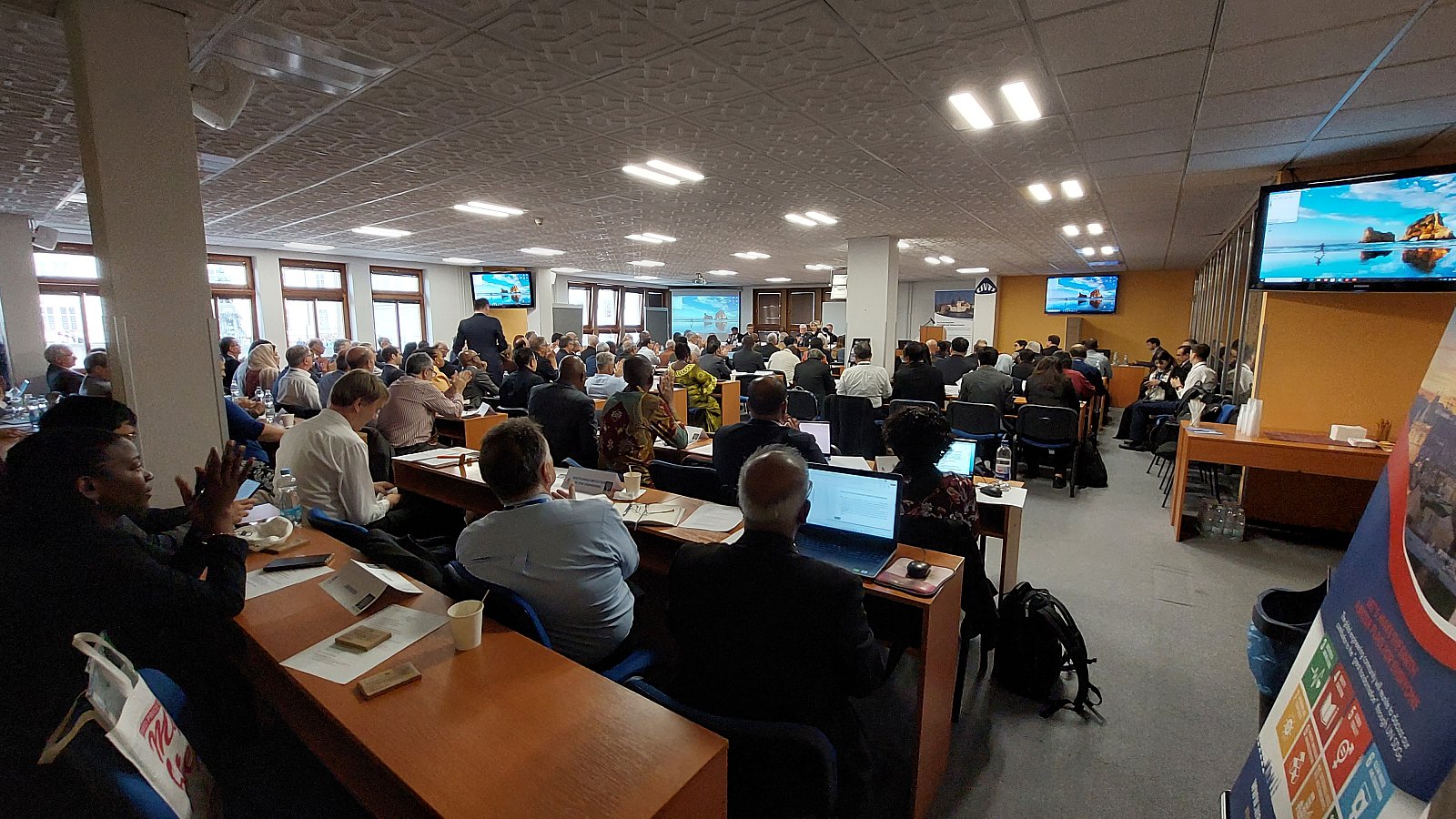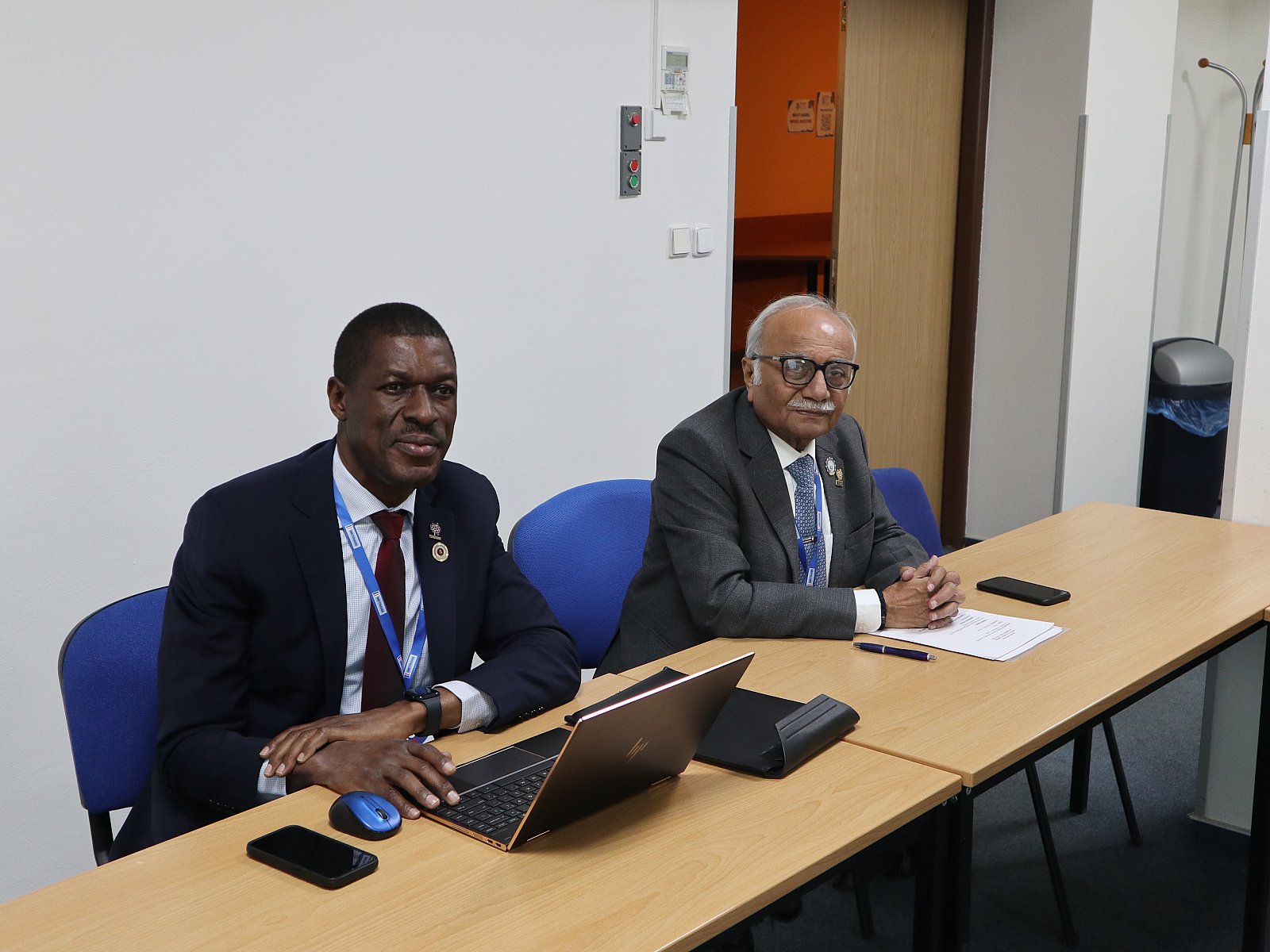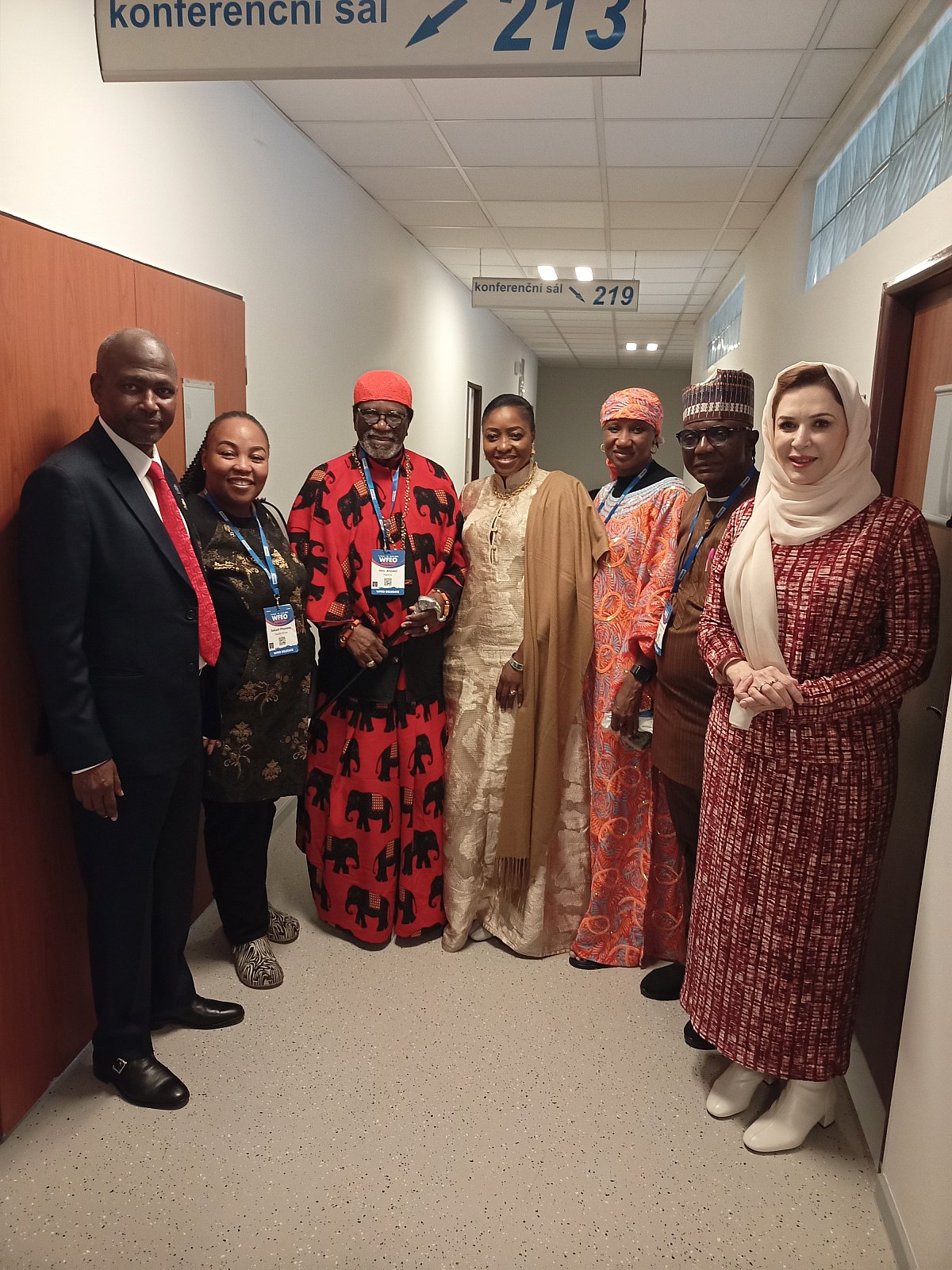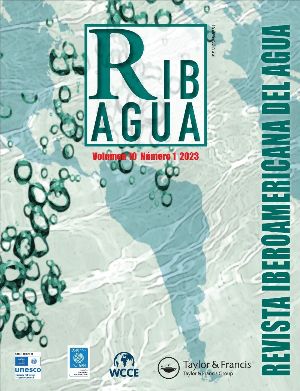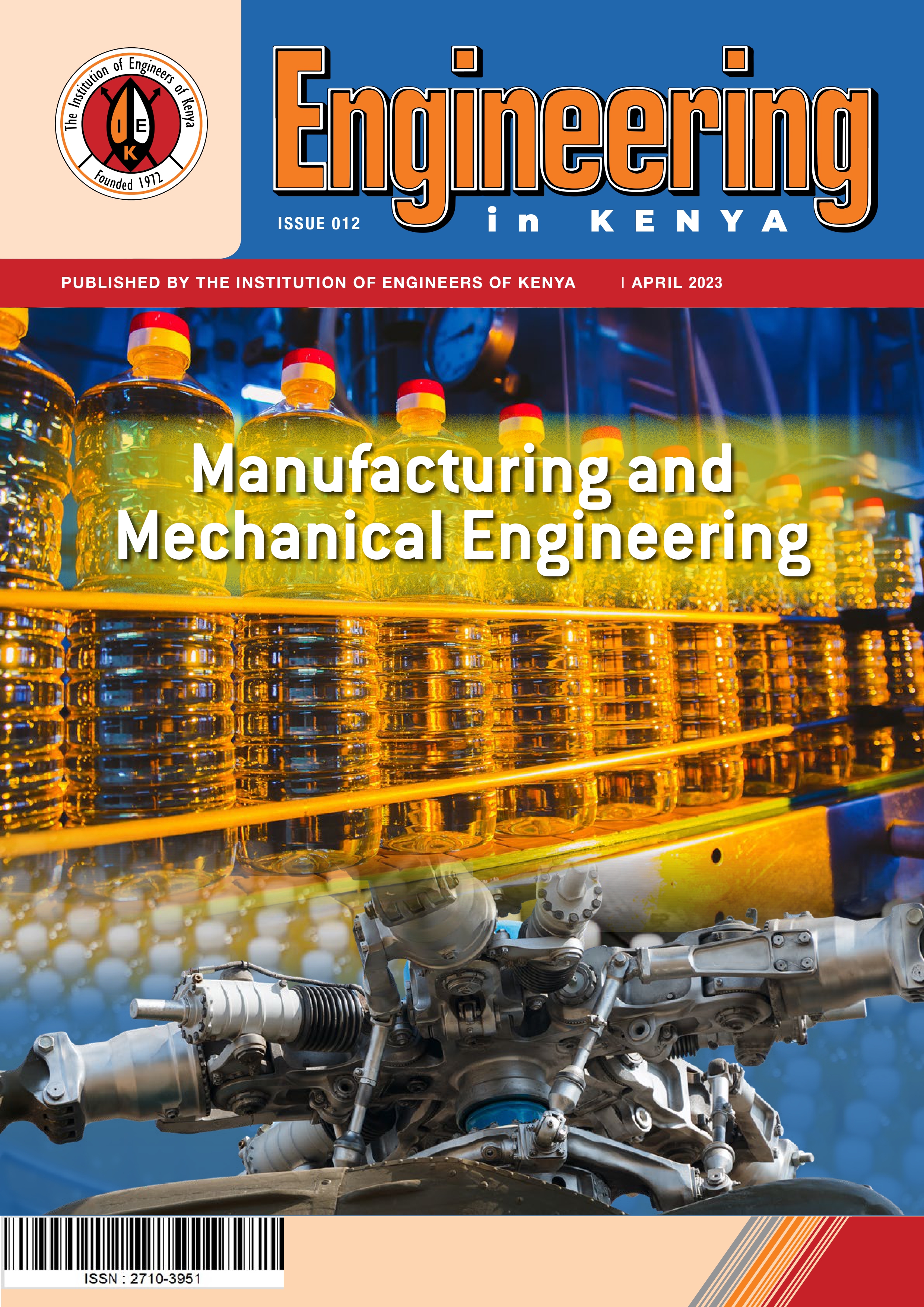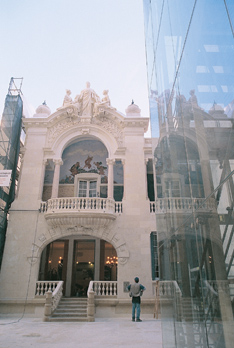 Autumn is coming and that is the time for WCCE's General Assembly. This time WCCE is travelling to old Europe as 9th WCCE's General Assembly will be hosted by ORDEM DOS ENGENHEIROS DE PORTUGAL, founding member of the organization. The activities regarding 9th WCCE General Assembly will be held from 21st to 25th November 2014 in Lisbon.
Autumn is coming and that is the time for WCCE's General Assembly. This time WCCE is travelling to old Europe as 9th WCCE's General Assembly will be hosted by ORDEM DOS ENGENHEIROS DE PORTUGAL, founding member of the organization. The activities regarding 9th WCCE General Assembly will be held from 21st to 25th November 2014 in Lisbon.
On the occasion of WCCE’s General Assembly, ORDEM will hold an international workshop on Heritage Building restoration at the same venue.
Saturday, 22 NOVEMBER 2014
PORTUGUESE ENGINEERS DAY
MORNING SESSION
8:30 Departure from Hotel
9:00 Bus transfer from Ordem dos Engenheiros to Caldas da Rainha
11:00-12:30 Social Programme - Vila de Óbidos Visit
13:00-14:00 Lunch - Congress Centre
NOON SESSION
14:30-15:00 Opening Session PORTUGUESE ENGINEERS DAY - Congress Centre
15:15-17:15 Standing Committee Meetings (Water/ Construction) - Hotel Sana Silver Coast
17:30-19:30 Standing Committee Meetings (Education/Natural Disasters) - Hotel Silver Coast
19:30-20:00 Departure to dinner from hotel
NIGHT SESSION
20:30-23:15 PORTUGUESE ENGINEERS' DAY Dinner - "A la Reira" Restaurant
23:30 Return to hotel in Lisbon
Sunday, 23 NOVEMBER 2014
MORNING SESSION
11:00-13:00 Executive Committee - Biblioteca OdE
NOON SESSION
15:00-17:00 City Tour
NIGHT SESSION
19:30 Departure from hotel
20:00 + General Assembly Gala Dinner - Tenda do Cristo Rei
Monday, 24 NOVEMBER 2014
MORNING SESSION
9:30 Departure from hotel to LNEC
10:00-12:00 Visit Laboratório Nacional de Engenharia Civil LNEC - National Laboratory for Civil Engineering
12:00-12:30 Return to OdE
12:45-14:00 Anticorruption Workshop (pending confirmation)- OdE Auditorium
NOON SESSION
14:00-16:00 Lunch - Ordem dos Engenheiros
16:30-19:30 Workshop - Urban rehabilitation - OdE Auditorium
NIGHT SESSION
20:00+ Free time
Tuesday, 25 NOVEMBER 2014
9th WCCE General Assembly meeting
MORNING SESSION
11:00-14:00 9th WCCE General Assembly - OdE Auditorium
14:00-16:00 Lunch - Ordem dos Engenheiros
NOON SESSION
16:00-19:00 9th WCCE General Assembly - OdE Auditorium
NIGHT SESSION
21:00 h+ Free time
26 NOVEMBER 2014
Delegations' Departure
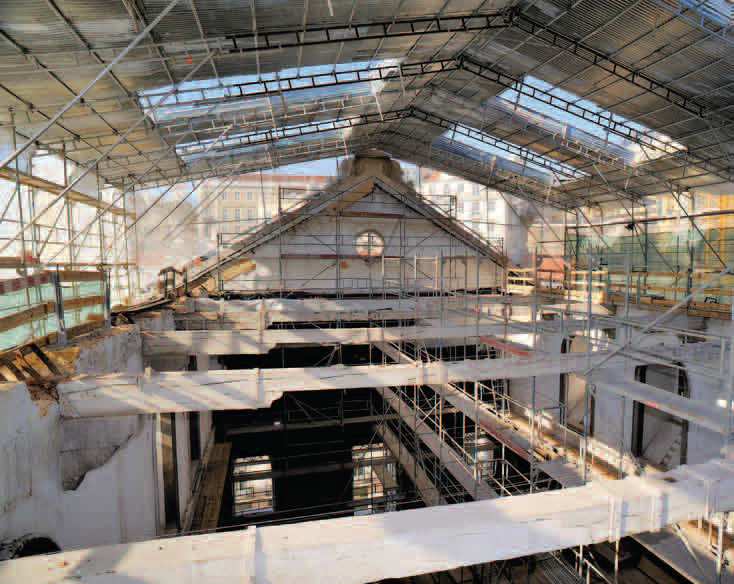
PROGRAM
SEISMIC STRUCTURAL CONSOLIDATION OF HISTORICAL AND MONUMENTAL BUILDINGS USING STEEL: INTERVENTIONS ON FOUNDATIONS AND ELEVATIONS
All consolidation designs to recover structural systems from damages due to earthquakes or any other natural or anthropic factor, should, therefore, must be strictly oriented to the safeguard of the historical and architectonical identity of the monument. Any intervention shall guarantee its full reversibility, that is to say the possibility to remove any reinforcing element laid down. Such reasons make consolidation with steel structures particularly eligible.
MASSIMO MARIANI
 Studio owner and freelance professional specialized in the restoration and disaster mitigation of heritage buildings in Italy. Professor in the University of Perugia's Master's Degree "Seismic improvement, restoration and consolidation of the built historic and monumental" and Sisto Mastrodicasa's centre of Studies professional development courses"
Studio owner and freelance professional specialized in the restoration and disaster mitigation of heritage buildings in Italy. Professor in the University of Perugia's Master's Degree "Seismic improvement, restoration and consolidation of the built historic and monumental" and Sisto Mastrodicasa's centre of Studies professional development courses"
Presently he is:
Perugia's Pietro Vannucci" Academy of Fine Arts Academician
Regional delegate of the Italian Association for the Restoration and Consolidation of Buildings
REHABILITATION, ENERGY EFFICIENCY AND HYGROTHERMAL PROBLEMS
The rehabilitation of existent buildings is crucial in Portugal taking into account the building stock degradation. The improvement of the energy efficiency is a great opportunity in this rehabilitation process. Nevertheless, the technical solutions need to be studied, so that buildings could have a good behaviour against moisture, an acceptable durability and to preserve the cultural heritage.
VASCO PEIXOTO DE FREITAS
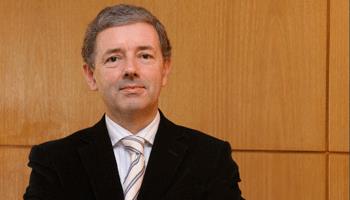 Full Professor at Faculty of Engineering – University of Porto (FEUP). Head of the Building Physics Laboratory and Building Rehabilitation Advanced Course at FEUP. Coordinator of CIB W040 – Heat and Moisture Transfer in Buildings and CIB W086 – Building Pathology. Author of more than 400 scientific publications on Building Rehabilitation, Building Pathology, Hygrothermal Behaviour and Building Physics and Consultant in Building Pathology and Building Rehabilitation.
Full Professor at Faculty of Engineering – University of Porto (FEUP). Head of the Building Physics Laboratory and Building Rehabilitation Advanced Course at FEUP. Coordinator of CIB W040 – Heat and Moisture Transfer in Buildings and CIB W086 – Building Pathology. Author of more than 400 scientific publications on Building Rehabilitation, Building Pathology, Hygrothermal Behaviour and Building Physics and Consultant in Building Pathology and Building Rehabilitation.
CASE STUDY: CAMPUS OF COUROS, GUIMARAES
Rehabilitation is mostly needed in historic city centres and progressively required in consolidated urban areas in Portugal. Urban rehabilitation is a relevant economic, social, cultural and environmental issue nowadays. Public initiative reveals essential for promoting large urban rehabilitation projects capable to incorporate all the above aspects. The Campus of Couros in Guimaraes is an interesting example on this topic.
JOSÉ CARDOSO TEIXEIRA
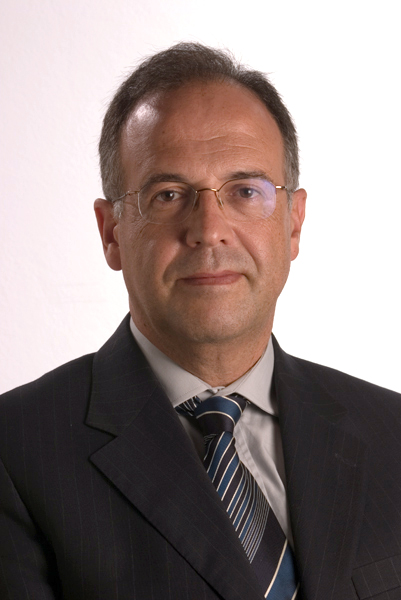 José Cardoso Teixeira is a civil engineer, master in building construction and PhD in construction management. He has worked as a site manager, designer, consultant and consulting company manager. He is an associate professor at the Civil Engineering Department of the University of Minho, Guimaraes, Portugal. He has been involved in the rehabilitation project of the Couros area in Guimaraes, Portugal.
José Cardoso Teixeira is a civil engineer, master in building construction and PhD in construction management. He has worked as a site manager, designer, consultant and consulting company manager. He is an associate professor at the Civil Engineering Department of the University of Minho, Guimaraes, Portugal. He has been involved in the rehabilitation project of the Couros area in Guimaraes, Portugal.
REHABILITATION STRATEGIES
It is presented a discussion of the rehabilitation strategies to be implemented in the European Buildings considering the following points: Maintenance and durability before rehabilitation!; How to rehabilitate? (energy and structural rehabilitation); How to finance the rehabilitation?.
The main documents and strategies from EU will be presented with the aim of making “Construction the leading industry to come out of the crisis”
FERNANDO BRANCO
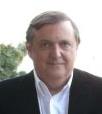 Full Professor of Civil Engineering at the University of Lisbon, where he is the Head the Construction Sector. He has been consultant for major public works like the S. João Rail Bridge (world longest railway span), International Guadiana Bridge (Spain), Macau-Taipa Bridge (China) and Vasco da Gama Bridge (the longest one in Europe).Modalities to be developed in the event
Full Professor of Civil Engineering at the University of Lisbon, where he is the Head the Construction Sector. He has been consultant for major public works like the S. João Rail Bridge (world longest railway span), International Guadiana Bridge (Spain), Macau-Taipa Bridge (China) and Vasco da Gama Bridge (the longest one in Europe).Modalities to be developed in the event
Presently he is:
President of the European Council of Civil Engineers (ECCE);
Vice-president of the International Assoc. for Bridge and Structural Engineering (IABSE);
President of the Portuguese Association for Structural Engineering (APEE).
ABOUT PORTUGAL
Located in South-Western Europe, on the Iberian Peninsula, and it is the westernmost country of mainland Europe, being bordered by the Atlantic Ocean to the west and south and by Spain to the north and east. Aside from continental Portugal, the Portuguese Republic holds sovereignty over the Atlantic archipelagos of Azores and Madeira, which are autonomous regions of Portugal. The country is named after its second largest city, Porto, whose name derives from Latin Portus and Celtic Cale.
The land within the borders of the current Portuguese Republic has been continually fought over and settled since prehistoric times. Celts, Romans have dominated this region, followed by the Visigothic and Suebian domination, and the Moorish invaders, who were eventually expelled during the Reconquista. Portugal by 1139 established itself as an independent kingdom from Galicia.[14] In the 15th and 16th centuries, as the result of pioneering the Age of Discovery, Portugal expanded western influence and established the first global empire, becoming one of the world's major economic, political and military powers, and ultimately dividing the world with Spain.
The Portuguese Empire was the longest-lived of the modern European colonial empires, spanning almost 600 years, from the capture of Ceuta in 1415 to the handover of Macau to China in 1999 (de facto) or the granting of sovereignty to East Timor in 2002 (de jure). The empire spread throughout a vast number of territories that are now part of 53 different sovereign states, leaving a legacy of over 250 million Portuguese speakers today (making it the sixth most spoken first language) and a number of Portuguese-based creoles. Portugal's international status was greatly reduced during the 19th century, especially following the Independence of Brazil, its largest and most important colony. After 1910 revolution deposed the monarchy, the democratic but unstable Portuguese First Republic was established, itself being superseded by the "Estado Novo" right-wing authoritarian regime. Democracy was restored after the Portuguese Colonial War and the Carnation Revolution in 1974. The revolution in 1974 also resulted in the independence of Angola, Mozambique, São Tomé and Príncipe, East Timor, Cape Verde and Guinea-Bissau in 1975.
Clothing
Lisbon's proximity to the coast makes for a more or less mild climate pleasant the year round. Average temperatures range from 11 Celsius to 17 Celsius in November. Lisbon can be a windy city, so you may want to wear a long-sleeved shirt or a light jacket if you are used to a warmer climate. Pack a light jacket, jeans, long-sleeved shirts and T-shirts, just in case.
Footwear
In addition to making it a nightmare to wheel your luggage around, the cobblestone streets in Lisbon are particularly unkind to women unaccustomed to navigating the city in heels or platforms. The chances are that you will also be doing a fair bit of walking, so comfortable footwear is a must. Men should also pack a pair of dress shoes and women should pack their most comfortable heels or platforms if they plan on going out to a nightclub or a nice restaurant. As with most European countries, the locals tend to dress up when they go out, so you will want to blend in if possible.
Currencies and Payment
The official currency is the EURO €. All prices are set in €, so it is highly recommended to change currency on arrival to the airport. Change is available in banks and hotels. Credit cards accepted include Cabal, Transcard, Visa and MasterCard. Registration fees will be paid in € or US $.
Immigration Regulations
All visitors must hold a valid passport and the corresponding visa or tourist card, except in cases of countries with which Portugal has visa exemption agreements. Tourist Card, both individual and groups, can be requested at the Portuguese representatives, travel agencies and airline offices.
Customs regulations
Free import to passengers (aged 17 years and older) arriving with goods purchased within the EU which are for personal use only: tobacco: 800 cigarettes, 400 cigarillos (max. 3g each), 200 cigars, 1kg smoking tobacco. Alcoholic beverages: 10 litres of spirits over 22%, 20 litres of alcohol beverages less than 22%, 90 litres of wine (though no more than 60 litres of sparkling wine), 110 litles of beer.
Free import to passengers arriving from non-EU Member States (incl. Aland Island, Canary Islands, Channel Islands and other similar territories) :
1. TOBACCO PRODUCTS, FOR PASSENGERS AGED 17 AND OLDER:
•200 cigarettes; or
•100 cigarillos (max. 3g each); or
•50 cigars; or
•250g of tobacco; or
•proportional assortment;
2. ALCOHOLIC BEVERAGES, FOR PASSENGERS AGED 17 AND OLDER:
•1 litre of spirits over 22% volume, or non-denatured ethyl alcohol with more than 80% volume; or
•2 litres of spirits or aperitifs made of wine or similar beverages less than 22% volume, or sparkling wines or liqueur wines; or
•- a proportional mix of these products; and in addition
•- 4 litres of wine; and
•- 16 litres of beer;
3. MEDICINAL PRODUCTS SUFFICIENT FOR PERSONAL NEEDS;
4. OTHER GOODS (FOR AIR TRAVELLERS) UP TO A TOTAL VALUE OF EUR 430.- (PER ADULT) OR EUR 150.- (PER PASSENGER AGED UNDER 15 YEARS).
Products of animal origin, not originating from an EU Member State , Andorra, Liechtenstein, Norway, San Marino or Switzerland, are not permitted to be imported into an EU Member State, with the exception of limited amounts from Andorra, Faeroe Isl., Greenland, Iceland and small amounts of specific products from other countries.
For full details, please see or refer to the website of the European Union, http://europa.eu/.
Eating Hours
Start your day with breakfast at any one of the numerous pastelarias (cafés or pastry shops), which are open all day and serve a selection of sweet and savoury pastries and great coffee.
Portuguese restaurants are usually open for lunch from 12:00 to 15:00. Dinner is served between 19:30 and 23:00 although there are always a few restaurants that are open until 02:00.
The Portuguese adore their snacks so if you feel a bit peckish in the evening, enjoy a light petisco (similar to Spanish tapas), which is served in many bars.
Health Regulations
Only required to present the International Certificate of Vaccination for travellers from countries where yellow fever and cholera are endemic or have been declared infected areas by WHO. There are restrictions on products of animal or vegetable.
Electric current
The local current in Portugal is 220 volts AC with a two-round-pin plug.
ABOUT LISBON
Lisbon (/ˈlɪzbən/ liz-bən; Portuguese: Lisboa, IPA: [liʒˈboɐ]) is the capital and the largest city of Portugal with a population of 547,631 within its administrative limits] on a land area of 84.8 square kilometres (32.7 sq mi). The urban area of Lisbon extends beyond the administrative city limits with a population of over 3 million] on an area of 958 square kilometres (370 sq mi), making it the 11th most populous urban area in the European Union. About 3,035,000 people live in the Lisbon Metropolitan Area (which represents approximately 27% of the population of the country). Lisbon is the westernmost large city located in Europe, as well as its westernmost capital city and the only one along the Atlantic coast. It lies in the western Iberian Peninsula on the Atlantic Ocean and the River Tagus.
History
While there are archeological proofs that the area has been inhabited since 30 thousand years ago, the city of Lisbon emerged as one of the most coveted after cities from the shore of the Atlantic such as the Old World used to be configured. As legends maintain, Lisbon was founded by the Greek traveler and hero Ulysses, while returning from the Trojan War, its original name, Ulissipo or Olissipo, meaning “enchanted port”. And, since all nations – from Phoenicians, Celts and Romans to Arabs and even Spaniards – coveted after dominating the city, this was truly an enchanted place.
During the Roman period, starting the second century, Lisbon became one of the most important cities in the Peninsula and was renamed Felicitas Julia. However, it was captured by the Moors in the 8th century, regaining its former name. The Moors resisted over 3 centuries the attacks of the Christian crusaders, losing the city in the first half of the 12th century. Since 1252, the city has been enjoying the status of capital of Portugal.
The age of discovery, from the 15th to the 18th century, marked the Enchanted Port as the main departure point of the Portuguese discovery expeditions. Explorers sailed from this city in the entire world, discovering new lands in South America, Africa, and even a new route to India. This made Portugal one of the ruling nations of Europe, while Lisbon was Europe’s most prosperous trading centre.
However, this prosperous age ended suddenly in 1755, when a devastating earthquake destroyed over half of the city’s buildings. The earthquake was followed by inland fires and an even more devastating tsunami, which ended the enchanted port’s reign over the oceans. Nevertheless, Lisbon was rebuilt on its ashes by the first Marquees de Pombal, Sebastiao Jose de Carvalho e Melo, with wider streets, a more modern city for a modern world.
In the 19th century, Lisbon was captured by Napoleon Bonaparte, most of its treasures and buildings being pillaged, stolen or simply destroyed. Lisbon was reborn again after the new king returned to the capital, being extended to the north, as a consequence of the industrial development.
In the early 20th century, after the regicide of Carlos I of Portugal (the king was killed in Lisbon in 1908), the city was the starting point of the republican coup in 1910, which established Portugal as a democratic republic.
Culture
Portuguese culture is an incredible amalgamation of foreign influences, from the extensive expeditions the Portuguese explorers made all over the world, to the Moorish and Roman invasions. In the streets of the city, travellers will be spellbound by the busy and energy of Lisbon, from the artists performing, businessmen bustling in their suits, vendors selling hot chestnuts, or children playing in the parks. The city itself is littered with historical landmarks, from the Baroque architecture to restored palaces, castles and regal churches. A mix of the old and new, Lisbon is overflowing with events, music, museums, and sights that display this diversity. Lisbon also seethes with grandeur, reminiscent of when this city was the heart of the most powerful, rich nation in the world.
In Lisbon, many different festivals are celebrated reflecting the people’s past beliefs in local pagan and roman gods as well as Christian saints. For instance, June is the most filled month in terms of Lisbon's festivals; these festivals honour different saints with parades and parties. In addition, on the second Sunday of lent, there is a parade of violet-covered litters in the Graça district; this ritual has gone on since the 16 th century.
In order to really live the June festivities in a local way, you should definitely visit the area of Alfama after 10 pm, around the area of Largo of São Miguel.
The famous music of Portugal is Fado, which means roughly ‘common human feeling.’ Much like its namesake, the music Fado is very emotional, if not melancholy in nature. The origins of the music are thought to be a combination of Arabic influence from Portuguese sailors and Africa slave music. Lisbon Fado (there are two types) is performed by women and communicates a mix of suffering, love, nostalgia and pain.
For music lovers, Lisbon has a host of world class music venues such as the Orquestra Sinfónica and the open-air amphitheatre of the Fundação Calouste Gulbenkian. The Teatro Nacional de Dona Maria II, at the top of the Praça de Dom Pedro IV (Rossio), is the most striking.
For dance, there is the Companhia Nacional de Bailado (Portuguese National Ballet) is based at the Teatro Camões in the Parque das Nações. Other venues that host dance performances are the Centro Cultural de Belém and the Fundação Calouste Gulbenkian.
Portuguese are also very passionate about poetry, whether it be from the 16 th century (i.e. Luis de Camões is one of the most famous) to modern (such as Alexandre Herculano or Fernando Pessoa). Triapsing through the streets of the old city, one can see why this culture is so conducive to poetry, romance and adventure. Fernando Pessoa is an amazing poet and you can get extremely inspired by his words!
World Heritage
The Monastery of the Hieronymites and Tower of Belem are two early 16th century historical buildings in the port of Lisbon. They symbolise the Portuguese Age of Discovery. They were built in the Portuguese Manueline style. The Monastery and adjacent church date from 1501, and were built on orders of King Manuel I. Its church became a house of prayer for seamen leaving or entering port. It later was turned into the burial place for Portuguese royalty. The tombs of the explorers Vasco da Gama and Luís de Camões are also here.
The nearby Tower of Belem was built as part of the defence system of Lisbon and ceremonial gateway into its harbour.
The following countries require visa for entering Schengen countries. In case you find your country in this list, please contact
| Afghanistan | Georgia | Palau |
| Albania | Ghana | Papua |
| Angola | Granada | N. Guinea |
| Arabia | Guinea | Perú |
| Saudí | Guinea Bissau | Qatar |
| Argelia | Guinea Ecuatorial | Rep. Centroafricana |
| Armenia | Guyana | Rep. Dem. del Congo |
| Azerbaiyán | Haití | Rep. Dominicana |
| Bahrain | India | Rusia |
| Bangladesh | Indonesia | Rwanda |
| Belarús | Irán | Salomón (islas) |
| Belice | Iraq | Samoa |
| Benin | Jamaica | S. Vicente y Granadinas |
| Bhután | Jordania | Santa Lucía |
| Birmania/myanmar | Kazajstán | Sto. Tomé y Príncipe |
| Bolivia | Kenia | Senegal |
| Bosnia Herzegovina | Kirguistán | Sierra Leona |
| Botswana | Kiribati | Siria |
| Burkina Faso | Kuwait | Somalia |
| Burundi | Laos | Sri Lanka |
| Cabo Verde | Lesoto | Sudáfrica |
| Camboya | Líbano | Sudán |
| Camerún | Liberia | Suriname |
| Chad | Libia | Swazilandia |
| China | Madagascar | Tailandia |
| Colombia | Malawi | Tanzania |
| Comoras | Maldivas | Tayikistán |
| Congo | Mali | Timor Oriental |
| Corea Norte | Marianas Del Norte | Togo |
| Costa De Marfil | Marruecos | Tonga |
| Cuba | Islas Marshall | Trinidad y Tobago |
| Djibouti | Mauritania | Túnez |
| Dominica | Micronesia | Turkmenistán |
| Ecuador | Moldova | Turquía |
| Egipto | Mongolia | Tuvalu |
| Emiratos Arabes | Mozambique | Ucrania |
| Unidos | Namibia | Uganda |
| Eritrea | Nauru | Uzbekistán |
| Etiopía | Nepal | Vanuatu |
| Filipinas | Níger | Vietnam |
| Fiji | Nigeria | Yemen |
| Gabon | Omán | Zambia |
| Gambia | Pakistán | Zimbabwe |
TIME REQUIRED ISSUING A VISA:
The maximum period for processing short stay (Schengen) visa applications is fifteen (15) calendar days from the date the application is submitted. This period can be extended to a maximum of 30 calendar days in specific cases, especially if a more detailed examination of the application is required. By way of exception, in specific cases in which additional documentation is required, this period can be extended to a maximum of 60 calendar days.
Visas are not granted on the spot and should be applied for well in advance in order to allow enough time to process them. The foreign national must collect his or her visa within two months of being notified that it has been granted. In the case of a resident’s, work, or student’s visa, the holder must obtain a foreign national’s identity card within one month of his or her entry into Spain.
WHAT IS THE COST OF A VISA?
A visa fee of €60 is payable to the Consulate of Portugal. An address list of the Portuguese Embassies and Consulates can be found here. This fee is non-refundable and therefore will not be refunded if the visa application is unsuccessful. There will be no charge for children under the age of 6. There will be no charge for the spouse and/or dependants of an EU citizen. However, proof of the relationship must be submitted at the time of application. This proof must be an original EU full national passport or national ID card and an original marriage certificate or civil partnership, (birth certificate in the case of children or dependants). Photocopies are not acceptable. Non EU Certificates should be legalized according to the 1961 Hague Convention.
The purpose of the visit and/or length of stay cannot be altered once the visa has been issued. Please check carefully when collecting passports that the visas are correct, any printing errors or omissions may affect the intended stay within the Schengen area.
Holders of Schengen visas are still subject to immigration control at the point of entry and are not guaranteed entry into any of the Schengen member countries, should they not comply with current travel regulations, even though they may hold a valid visa for these countries.
HOW LONG IS THE VISA VALID FOR?
Short Stay or Schengen Visas are valid for short stays (up to 90 days)
PLACE OF APPLICATION:
The visa is requested and issued in the Portuguese diplomatic missions and consular offices.
Where there is no Portuguese diplomatic mission or consular office in a particular country, a transit or visitor’s visa can be requested from the diplomatic mission or consular office which represents Spain in that country.
ARRIVAL AND TRAVEL TO THE HOTEL
FROM THE AIRPORT:
“Aerobus 1” – Price: 3.50€. Unrestricted luggage allowance and valid for the entire bus network on the day of purchase.
Bus 744 – Price: 1,40€. (All buses stop in front of SANA Lisboa).
Taxi – Price: 12 to 20€, according to the time of the day and amount of luggage.
Transfer – Contact us and we will pick you up at the airport (paid service)
Car – Follow the signs for the “Centro” or “Marquês de Pombal”. Join the 2nd Circular and exit to the right in the direction of Campo Grande. Turn right again and enter the tunnel, driving straight on. Pass Av. da República and continue on until you reach Av. Fontes Pereira de Melo. SANA Lisboa Hotel is on the left, at the end of the avenue. To stop the car in front of the hotel, continue straight on to the Marquês de Pombal roundabout, and take the 5th exit, changing direction. To go directly to the car park, take the 4th exit from the Marquês de Pombal roundabout towards Av. Duque de Loulé. Turn left at the 1st exit (traffic lights) and follow the road until the SANA Lisboa Hotel Parque de Estacionamento sign, on your left.
FROM SOUTH TO NORTH:
Follow the signs for the Centro or Marquês de Pombal.
TRANSPORT NEARBY:
Underground: Marquês de Pombal Station (Blue and Yellow Lines)
Bus: Airport – Aerobus 1; Centre – 736 and 36; Lisbon/ Belém Conference Centre – 727; Parque das Nações – 744; Feira da Ladra – 712
Taxis: In front of the hotel
SANA HOTEL LISBON ****
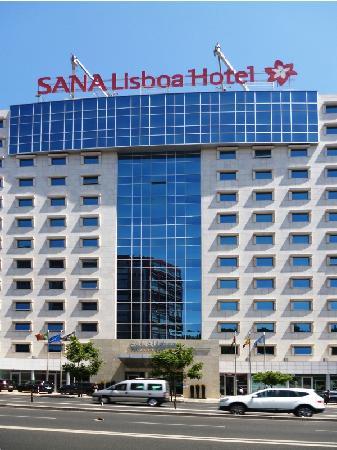 With a privileged location and excellent access routes, SANA Lisboa Hotel is ideally situated to explore the best that Lisbon has to offer. Situated in Avenida Fontes Pereira de Melo, a few steps from Praça do Marquês de Pombal, as well as from Picoas and Saldanha, the hotel is easily reached from Lisbon airport by public transport (AeroBus) or a short taxi journey.
With a privileged location and excellent access routes, SANA Lisboa Hotel is ideally situated to explore the best that Lisbon has to offer. Situated in Avenida Fontes Pereira de Melo, a few steps from Praça do Marquês de Pombal, as well as from Picoas and Saldanha, the hotel is easily reached from Lisbon airport by public transport (AeroBus) or a short taxi journey.
Av. Fontes Pereira de Melo, 8 - 1069-310 Lisbon
Cost per night
|
||
| ACCOMODATION | Single Room | Double Room |
|
Sana Hotel Lisbon **** |
||
| Standard. Room | Approx. 90€ /night | Approx. 100€ /night |
Other accommodation options
HF FÉNIX URBAN ****
 HF Fenix Urban is located near the congress venues. The hotel is easily reached from Lisbon airport by public transport (AeroBus) or a short taxi journey.
HF Fenix Urban is located near the congress venues. The hotel is easily reached from Lisbon airport by public transport (AeroBus) or a short taxi journey.
Avenida António Augusto de Aguiar 14, 1050-016 Lisbon
Cost per night
|
||
| ACCOMODATION | Single Room | Double Room |
| HF Fenix Urban **** | ||
| Standard. Room | Approx. 61€ /night | Approx. 64€ /night |
PLEASE Carboncopy any request to WCCE Secretariat This email address is being protected from spambots. You need JavaScript enabled to view it.
There will be a formal accompanying persons’ program. Several activities may arise but will be managed on the spot. Further details will be delivered on short notice. Visits are to be offered to several heritage sites like the following:
TOWER OF BELEM
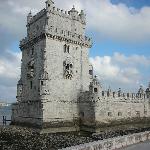 The tower was built in the early 16th century and is a prominent example of the Portuguese Manueline style, but it also incorporates hints of other architectural styles. The structure was built from lioz limestone and is composed of a bastion and the 30 m (100 foot), four storey tower. It has incorrectly been stated that the tower was built in the middle of the Tagus and now sits near the shore because the river was redirected after the 1755 Lisbon earthquake. In fact, the tower was built on a small island in the Tagus River near the Lisbon shore.
The tower was built in the early 16th century and is a prominent example of the Portuguese Manueline style, but it also incorporates hints of other architectural styles. The structure was built from lioz limestone and is composed of a bastion and the 30 m (100 foot), four storey tower. It has incorrectly been stated that the tower was built in the middle of the Tagus and now sits near the shore because the river was redirected after the 1755 Lisbon earthquake. In fact, the tower was built on a small island in the Tagus River near the Lisbon shore.
PRACA DO COMERCIO
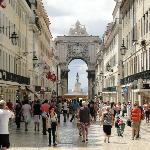 One of the biggest squares in Europe, this stylish area in downtown Lisbon often displays beautiful works of art and sculpture, and is a great place for a leisurely stroll.
One of the biggest squares in Europe, this stylish area in downtown Lisbon often displays beautiful works of art and sculpture, and is a great place for a leisurely stroll.
PADRAO DOS DESCOBRIMENTOS
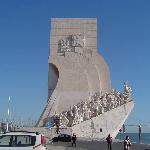 The discoveries monument is located at Avenida de Brasilia, in the Belem district. It is beside the Tagus river estuary. The monument was completed in 1960 during the 500 year anniversary of the death of Henry the navigator (1394-1469), who was the third son of Joao i. Henry the navigator financed the expeditions to the African coast and also founded a school of navigation in the Algarve. The monument celebrates the Portuguese age of discovery during the 15th and 16th centuries. The monument has the shield of Portugal on both sides and the sword of the royal house over the doorway. There are 33 statues on the monument that represent monarchs, explorers, cartographers, artists, scientists and missionaries. The architect of the monument was Cottinelli Telmo and the sculptor was Leopoldo de Almeida.
The discoveries monument is located at Avenida de Brasilia, in the Belem district. It is beside the Tagus river estuary. The monument was completed in 1960 during the 500 year anniversary of the death of Henry the navigator (1394-1469), who was the third son of Joao i. Henry the navigator financed the expeditions to the African coast and also founded a school of navigation in the Algarve. The monument celebrates the Portuguese age of discovery during the 15th and 16th centuries. The monument has the shield of Portugal on both sides and the sword of the royal house over the doorway. There are 33 statues on the monument that represent monarchs, explorers, cartographers, artists, scientists and missionaries. The architect of the monument was Cottinelli Telmo and the sculptor was Leopoldo de Almeida.
Registration to the Congress is compulsory to WCCE General Assembly attendees. WCCE activities are included in the following registration fees. Payment is to be delivered IN CASH (€ or $) on arrival to the hotel on the WCCE registration booth.
9th WCCE General Assembly
Registration Fees
|
CATEGORY |
FEE |
|
|
|
|
Delegate |
200 € |
|
Accompanying person |
100 € |
|
Rates with VAT included |
|
Delegate rates INCLUDE:
- Admission to all Congress sessions and worhshops.
- Congress documents, abstracts book and pack
- Work days' lunch
- City Tour
- Portuguese day of Engineers' Lunch & Dinner
- WCCE Gala dinner
- Admission to all WCCE seminars, sessions.
- General Assembly documents
- Coffee Breaks
Accompanying person's rates INCLUDE:
- Portuguese day of Engineers' Lunch & Dinner
- Congress Welcome Cocktail
- Lunch
- WCCE Gala dinner
- City Tour


